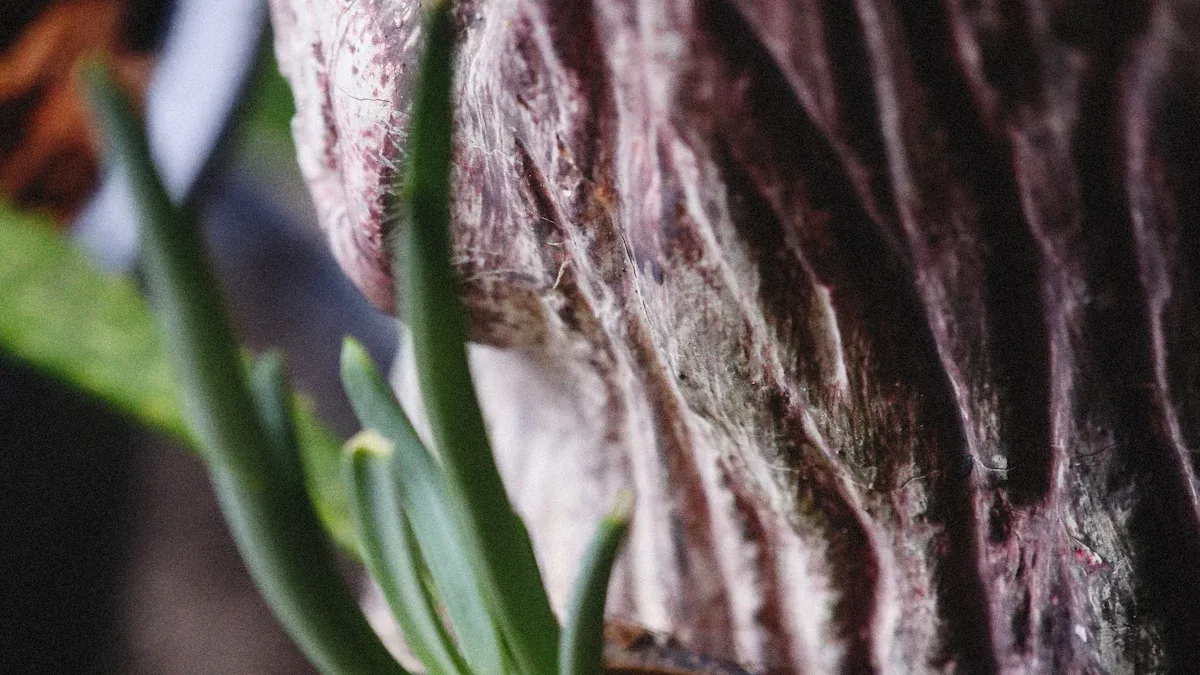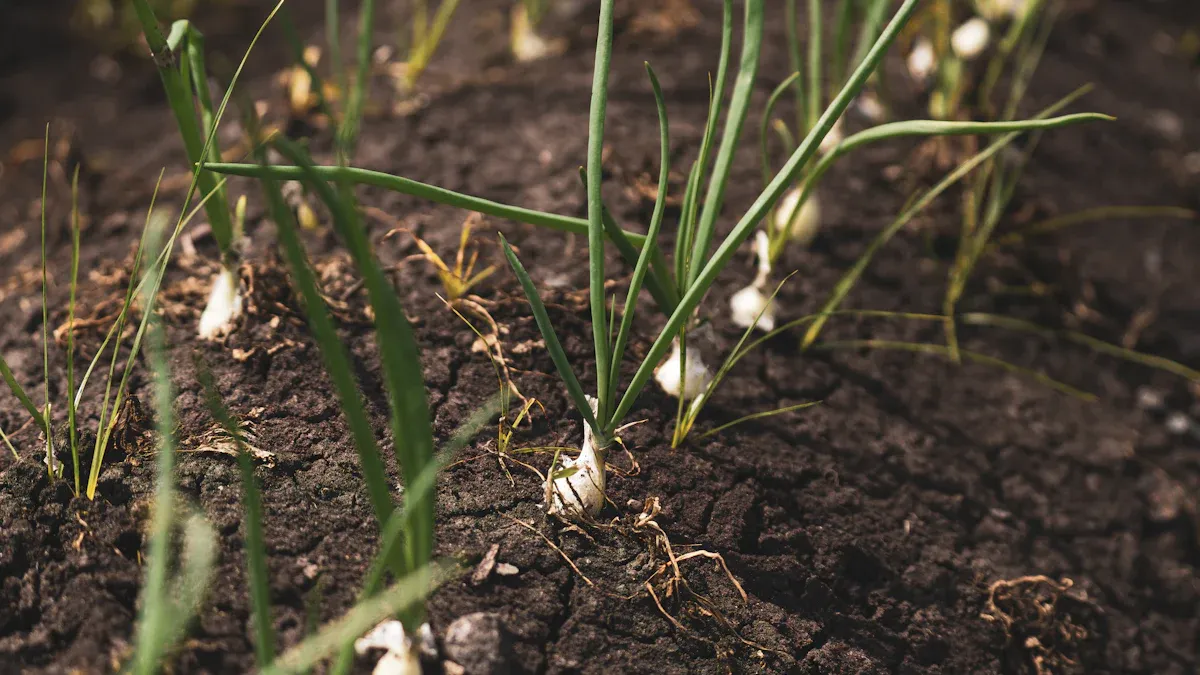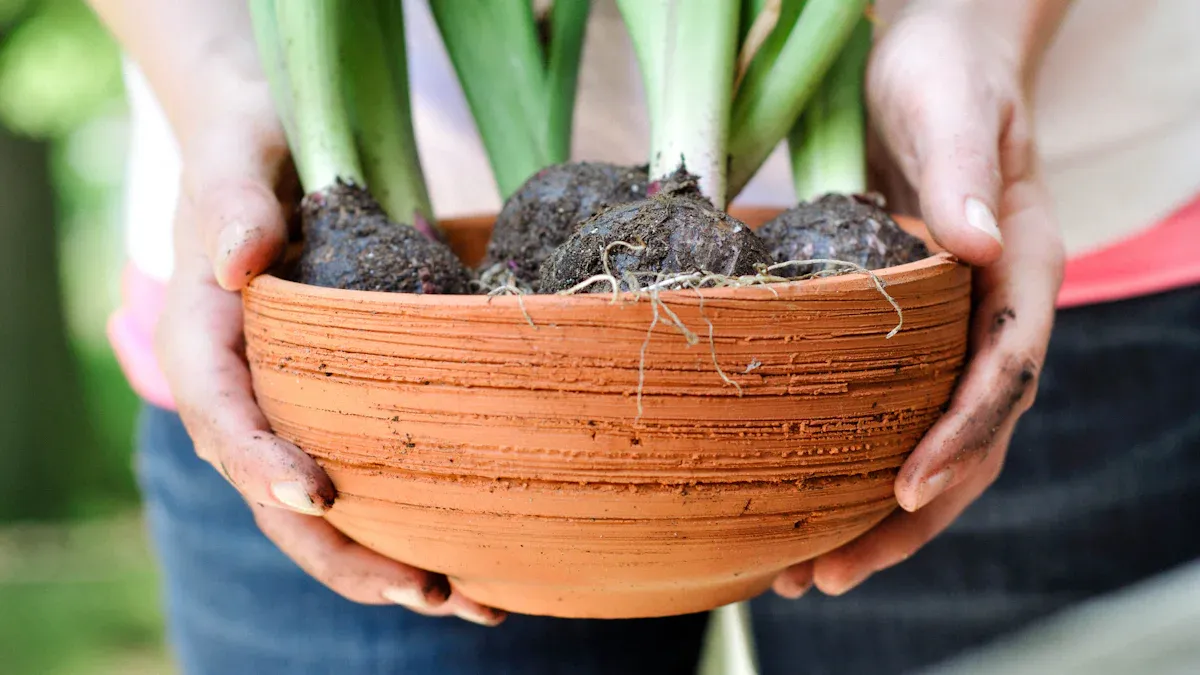
You’ve nurtured your onion plant with care, but now it’s wilting before your eyes. Frustrating, isn’t it? Onions play a vital role in cooking and gardening, enriching dishes worldwide. Watch for signs like yellowing leaves or drooping stems. These symptoms can help you save a dying onion plant before it’s too late!
Key Takeaways
Watch for signs of distress in your onion plant, such as yellowing leaves and wilting. Early detection can help you take action before it’s too late.
Adjust your watering practices by checking soil moisture regularly. Use the ‘knuckle rule’ to determine when to water and avoid overwatering.
Diagnose nutrient deficiencies and pests promptly. Fertilize with the right nutrients and manage pests using organic methods to support your onion’s recovery.
Symptoms of Dying Onions
Recognizing the symptoms of a dying onion plant early can make all the difference in saving it. Here are some common signs to watch for:
Yellowing Leaves
If you notice your onion’s leaves turning yellow, it’s a red flag. This can happen for several reasons, including nutrient deficiencies or diseases. For instance, Fusarium Basal Rot causes leaves to yellow from the tip down and eventually wilt. Other diseases like white rot can also lead to stunted growth and yellowing leaves. Keep an eye on your plants, as early detection is key!
Wilting or Drooping
Wilting or drooping leaves often signal that your onion plant is struggling. This can stem from overwatering, which leads to waterlogged soil, or underwatering, resulting in crispy, dry leaves. Nutrient deficiencies, particularly in nitrogen and potassium, can also cause yellowing and drooping. Environmental stressors, like extreme temperatures, can further exacerbate these issues.
Tip: Check your soil moisture regularly to find the right balance for your onions!
Root Rot Signs
Root rot is another serious issue that can affect your onion plants. Look for visual indicators like yellowing and curling leaves. Physical signs include dark, transparent roots and a discolored basal stem plate. Diseases like Fusarium Basal Rot and Pink Root can cause these symptoms. If you suspect root rot, act quickly to assess the roots and consider repotting.
By being vigilant and recognizing these symptoms, you can take steps to save a dying onion plant before it’s too late!
Diagnosing Issues to Save a Dying Onion Plant

When your onion plant shows signs of distress, diagnosing the underlying issues is crucial. You can take several steps to assess its condition and pinpoint the problem. Here’s how to get started:
Overwatering Problems
Overwatering is one of the most common issues that can lead to a dying onion plant. If your plant’s leaves are yellowing and wilting, check the soil. Is it soggy? If so, you might be giving your onions too much water. Here are some diagnostic steps to consider:
Monitor environmental conditions: Keep an eye on the weather. Excessive rain or humidity can lead to overwatering.
Keep accurate records: Document how often you water your plants. This helps you identify patterns that may contribute to overwatering.
Conduct soil tests: Test the soil for drainage. If water doesn’t drain well, it can lead to root rot.
Tip: Allow the top inch of soil to dry out before watering again. This helps maintain the right moisture balance.
Nutrient Deficiencies
Nutrient deficiencies can also cause your onion plant to decline. If you notice stunted growth or discoloration, it might be time to assess the nutrients in your soil. Here’s a quick guide to common nutrient deficiencies and their symptoms:
Nutrient | Symptoms |
|---|---|
Boron | Growth retardation, necrosis |
Calcium | Deformation, die off |
Copper | Discoloration, growth retardation |
Iron | Chlorosis, paling |
Magnesium | Dark green color, growth retardation |
Phosphorus | Dark green color, growth retardation |
Sulfur | Chlorosis, growth retardation |
Zinc | Chlorosis, deformation |
If you suspect a deficiency, consider fertilizing your onions with a balanced fertilizer. This can help restore their health and vigor.
Pest Infestations
Pests can wreak havoc on your onion plants, leading to significant damage. Common pests include onion thrips, leafminers, and onion maggots. Here’s how to identify them:
Pest | Symptoms/Effects |
|---|---|
Onion Thrips | Silvery blotches, distorted leaves, potential plant death |
Leafminers | White trails on leaves, premature leaf drop |
Onion Maggots | Stunted growth, bulb rot |
If you notice any of these pests, act quickly. You can use insecticidal soap or neem oil to manage infestations effectively. Regularly inspecting your plants can help catch these pests early.
By diagnosing these issues, you can take the necessary steps to save a dying onion plant. Remember, early intervention is key to restoring your plant’s health!
Solutions for Recovery

When your onion plant shows signs of distress, it’s time to take action. Here are some effective solutions to help you save a dying onion plant.
Adjusting Watering Practices
Watering correctly is crucial for your onion plant’s recovery. You want to maintain consistent moisture without overdoing it. Here’s how to adjust your watering practices:
Use the ‘knuckle rule’: Stick your finger into the soil up to the first knuckle. If you don’t feel moisture, it’s time to water. Aim to provide about one inch of water each time you water.
Water deeply but infrequently: Onions have shallow roots, mostly in the top 12 inches of soil. Light, frequent watering when the plants are small helps them establish. As they grow, increase the amount of water to support bulb development.
Be mindful of stress periods: Water stress during critical growth phases, especially from mid-May to early July, can hinder bulb production. Make sure your onions get enough water during these times to promote healthy foliage and bulb growth.
Tip: Always check the weather. If it’s been rainy or humid, you might need to cut back on watering.
Fertilizing Correctly
Fertilizing your onion plants can give them the nutrients they need to bounce back. Here’s how to do it right:
Choose the right nutrients: Onions thrive on nitrogen, phosphorus, and potassium. Here’s a quick guide on application rates:
Nutrient | Recommended Application Rate |
|---|---|
Nitrogen | 180-190 lbs N/acre total, with 10-20 lbs for young crops |
Phosphorus | 61-98 lbs P2O5 based on removal with harvest |
Potassium | Important in the last two months before harvest |
Use organic sources: Consider using feather meal, bone meal, or blood meal for nitrogen. These options can improve soil health and reduce pest issues.
Avoid over-fertilizing: Too much fertilizer can lead to high nitrate levels, which pose health risks. Split applications of nitrogen can help manage this risk while still supporting growth.
Note: Reducing synthetic fertilizer rates can decrease pest infestations and disease incidence, leading to healthier plants.
Managing Pests Effectively
Pests can be a significant threat to your onion plants. Here are some strategies to manage them effectively:
Implement integrated pest management: Use a combination of methods to control pests. Here are some effective strategies:
Trap crops: Plant marigolds to attract pests away from your onions.
Crop rotation: Change your planting areas each season to disrupt pest life cycles.
Companion planting: Grow pest-repelling plants alongside your onions to reduce infestations.
Maintain soil health: Healthy soil can prevent pest susceptibility.
Use organic pesticides: If pest pressure becomes severe, consider organic options like spinosad or pyrethrin. Always follow label instructions and apply in the evening to protect beneficial insects.
Tip: A few pests are normal and won’t significantly impact your harvest. Focus on managing them rather than trying to eliminate every single one.
By following these solutions, you can effectively save a dying onion plant and help it thrive again. Remember, recovery takes time, so be patient and attentive to your plants’ needs.
In summary, you can save your dying onion plant by recognizing symptoms early and diagnosing issues like overwatering, nutrient deficiencies, and pests. Take action by adjusting your watering practices, fertilizing correctly, and managing pests effectively. With proper care, your onions can thrive again! 🌱 Remember, consistent watering and good soil health are key!
FAQ
What causes my onion plant’s leaves to turn yellow?
Yellowing leaves often indicate overwatering, nutrient deficiencies, or diseases. Check your watering habits and soil health.
How often should I water my onion plants?
Water your onions when the top inch of soil feels dry. Aim for about one inch of water weekly.
Can I save an onion plant with root rot?
Yes! Trim away affected roots, repot in fresh soil, and adjust your watering practices to prevent future issues.
